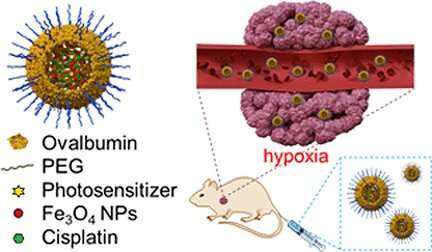Synergistic anticancer therapy with two cell killer agent systems in one nanocapsule

In their quest to destroy cancer cells, researchers are turning to combinational therapies more and more. Scientists from Germany and China have now combined a chemotherapeutic and photodynamic approach. All agents are encapsulated in nanocapsules with a protein shell to be delivered to the tumor. There, light irradiation triggers a cascade of events, which lead to the destruction of the tumor cells, the researchers write in the journal Angewandte Chemie.
Different anticancer agents use different strategies. DNA-damaging agents make the DNA dysfunctional so the tumor cannot grow. Photodynamic agents generate reactive oxygen species (ROS) when irradiated with light. These ROS then interfere with organelles in the cell and push the cells toward programmed cell death known as apoptosis.
However, some cancer types have developed resistances. Either the drug cannot enter the cell or the cells quickly repair the damaged DNA strands. To enhance effectivity, Katharina Landfester and her colleagues from the Max Planck Institute for Polymer Research, Mainz, Germany, and researchers from Dalian University of Technology, Dalian, China, combined chemotherapeutic and photodynamic agents. All agents were packed inside a nanocapsule for delivery to the tumor cells.
Photodynamic therapy can be less effective in solid tumors within which the oxygen level is too low to generate enough ROS. Therefore, the scientists used a modified system that partly recycles oxygen. In this system, a photosensitizer produces ROS after light irradiation. Enzymes of the cell convert the ROS to hydrogen peroxide. Another reagent called Fenton reagent—which is basically iron in its highest oxidation state—then back-transforms the hydrogen peroxide to ROS and oxygen.
The authors said that it was challenging to assemble all reagents in one nanocapsule. The chemotherapeutic agent, cisplatin, is poorly soluble in water, while ovalbumin, the nanocapsule protein, does not dissolve in the organic solvent. Using a miniemulsion technique, the scientists eventually combined all three reagents in a solvent mixture and wrapped them up in a shell of ovalbumin. They stabilized and emulsified these nanocapsules by adding a copolymer based on poly(ethylene glycol).
The scientists tested this system on tumor cell lines. The nanocapsules entered the cells, released their loads, and developed ROS when irradiated with red light. The agent set also killed cells that were resistant to cisplatin or had a particularly low oxygen concentration.
The combined encapsulated drugs also stopped tumor growth in live mice. The authors found that the reagents accumulated in the tumor tissue. They also made the tumors shrink over time without affecting healthy tissue or other organs.
The authors highlighted that the anticancer agents were delivered to the tumor in nanocapsules and worked synergistically. Treatments involving only one agent, or a combination of two, were much less effective. The authors proposed that similar synergistic platforms will play a major role in future therapy settings.
More information: Shuai Jiang et al. Synergistic Anticancer Therapy by Ovalbumin Encapsulation‐Enabled Tandem ROS Generation, Angewandte Chemie International Edition (2020). DOI: 10.1002/anie.202006649




















